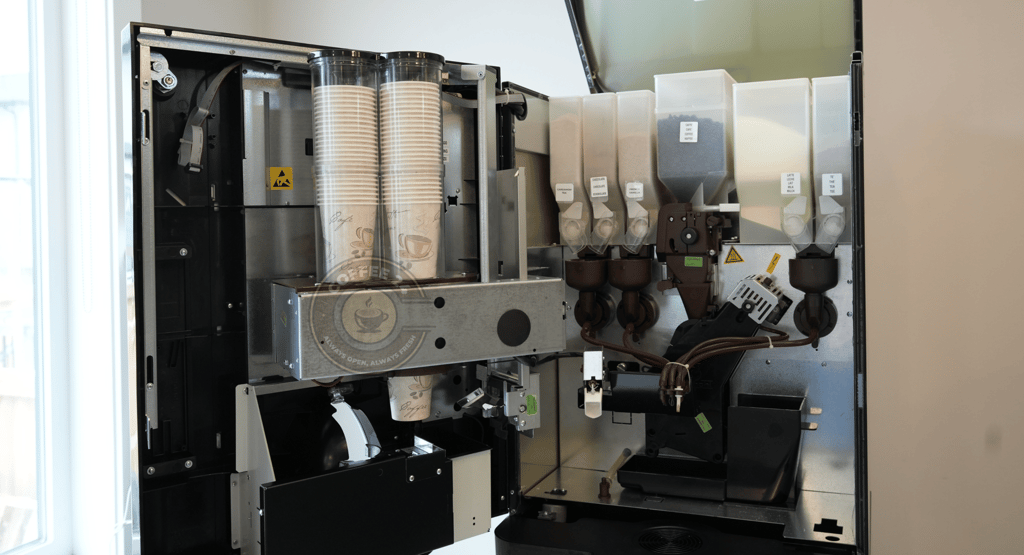Pods vs. Bean-to-Cup Coffee Machines: What’s Better for Your Office?
7/26/20254 min read


Introduction to Coffee Machines in the Office
In today's fast-paced office environment, having access to high-quality coffee is essential for fostering a productive workplace culture. Coffee not only serves as a warm beverage to energize employees but also facilitates social interactions and promotes collaboration among colleagues. The presence of a quality coffee machine in the office can significantly enhance the overall atmosphere, catering to diverse preferences and ensuring that everyone has the opportunity to enjoy their favorite brew.
There are various types of coffee machines available to meet the needs of an office setting, each offering distinct advantages and disadvantages. Among the most popular options are single-use pod machines and bean-to-cup coffee machines. Single-use pod machines allow for quick and easy preparation of coffee, often with minimal cleanup required. They offer a range of flavors and strengths but may raise concerns regarding sustainability due to the environmental impact of disposable pods. On the other hand, bean-to-cup machines provide the freshness of freshly ground beans, offering richer flavors and customizable brewing options, although they may require more maintenance compared to their pod counterparts.
This comparison aims to evaluate the strengths and weaknesses of both pod and bean-to-cup coffee machines specifically for office use. Factors such as brewing quality, cost-effectiveness, ease of use, maintenance requirements, and employee satisfaction will play a pivotal role in determining the most suitable choice for an office environment. By examining these critical attributes, offices can make an informed decision about which coffee machine will best cater to their unique requirements, ultimately contributing to enhanced productivity and employee morale.
Flavor and Quality Comparison
When comparing pods and bean-to-cup coffee machines, flavor and quality stand out as key factors influencing the choice for office use. Coffee brewed from beans typically ensures a fresher and more robust flavor compared to pod machines. This distinction largely arises from the freshness of the ingredients; whole coffee beans retain their essential oils and flavors, providing a richer cup of coffee. In contrast, pod machines often rely on pre-packaged coffee pods that can lose their flavor profile over time due to exposure to air and moisture.
The richness of flavor is also more pronounced with bean-to-cup machines, which grind the coffee beans immediately before brewing. This process maximizes the extraction of flavors, resulting in a drink that is more pronounced and aromatic. On the other hand, pods can offer convenience and a variety of flavors, but they may lack the depth found in freshly brewed coffee. Some pod manufacturers have improved the quality of their products, introducing specialty flavors; however, they often still cannot match the superior quality associated with freshly ground beans.
Moreover, the range of coffee options available can also differ significantly between the two methods. Bean-to-cup machines provide flexibility, allowing users to experiment with different coffee beans from various origins, roasting levels, and flavor profiles. Conversely, while pod machines often come with a multitude of flavor options, these options can be limited to a certain range provided by the manufacturer. Additionally, the choice of high-quality coffee beans is crucial in influencing taste, and using premium beans can elevate the coffee experience, making bean-to-cup appliances a favored choice for aficionados.
Ultimately, while both machines cater to various preferences and needs, in terms of flavor and quality, bean-to-cup machines tend to offer a superior coffee experience that is likely to satisfy discerning coffee drinkers in the workplace.
Cost Analysis: Pods vs. Bean-to-Cup
When evaluating the cost-effectiveness of coffee options for an office, it’s essential to consider both the initial investment and the ongoing operational expenses. Pod machines typically have a lower upfront cost, often ranging from $50 to $200, making them an accessible choice for many workplaces. However, the price per cup of coffee produced by these machines can be significantly higher when the cost of pods is taken into account. Generally, coffee pods range from $0.50 to $1 per pod, depending on the brand and quality, leading to an annual expenditure that can quickly accumulate, especially in a high-demand environment.
In contrast, bean-to-cup coffee machines require a more considerable initial investment, often starting from $500 to upwards of $2,000. This cost may deter some office managers; however, bean-to-cup machines offer substantial long-term savings. The cost per cup for these machines is generally lower, averaging approximately $0.30 to $0.40, as they utilize bulk coffee beans rather than individual pods. Over time, the savings can add up significantly, particularly in larger offices where coffee consumption is high.
Add to this the ongoing maintenance costs associated with each type of machine. Pod machines require frequent pod restocking, and if the office enjoys regular coffee consumption, these expenses can escalate quickly. Moreover, the environmental impact and waste generated by pod disposals can lead to indirect costs for companies aiming for sustainability. Bean-to-cup machines, while initially pricier, do not carry the same ongoing material costs and may only require occasional cleaning and maintenance, making them a more sustainable and economical choice in the long run.
Ultimately, an in-depth analysis of both the upfront investment and the ongoing costs associated with each type of coffee machine can guide office managers in making a well-informed financial decision for their coffee services.
Environmental Impact and Sustainability
The choice between single-use coffee pods and bean-to-cup coffee machines has significant environmental implications that deserve careful consideration, particularly in office settings. Single-use coffee pods, while convenient, generate a considerable amount of waste. Many of these pods are made from plastic that is not recyclable in standard municipal systems. As a result, millions of pods end up in landfills each year, contributing to environmental degradation and pollution. The production of these pods also requires energy and resources, compounding their overall carbon footprint.
In contrast, bean-to-cup coffee machines are generally considered to be a more sustainable option. These machines utilize whole coffee beans rather than pre-packaged pods, leading to minimal waste generation. Coffee grounds produced by these machines can often be composted, contributing to a circular economy and reducing overall environmental impact. Moreover, bean-to-cup machines typically require fewer resources throughout their lifecycle when compared to the continuous production and disposal cycles associated with coffee pods.
Companies like Coffee24 are committed to promoting sustainable coffee culture in workplaces. They not only offer eco-friendly bean-to-cup coffee machines but also focus on responsible sourcing of coffee beans. By ensuring their coffee is ethically sourced, Coffee24 supports sustainable farming practices that benefit local communities while reducing the carbon footprint associated with coffee production. Additionally, their flexible payment options facilitate a shift to greener practices for companies, allowing organizations to invest in sustainable equipment without straining their budgets. By considering these factors, businesses can significantly reduce their environmental footprint while providing high-quality coffee to their employees.
Coffee 24
info@coffee24.ca
Elevate Your Workspace
+1-431-336-1212
